Basil is a tender herb, and when the cool Fall weather comes in, basil is the first thing to go in our Minnesota garden. Unlike the woodier herbs, basil loses much of its flavor when dried, so the best way to preserve the basil for the Winter months is by freezing. Unfortunately, it loses its bright green color when frozen, but if you freeze it as a basil pesto, you are preserving both the taste AND the color. It’s easy!

Jump to: RECIPE | What is Pesto? | For Freshest Flavor in Winter | How to Freeze | How to Use Pesto Sauce
Origins of Pesto
Pesto is a delicious and much loved sauce “crudo” (raw) made from Genovese Basil, a cultivar of sweet basil named for the city of Genoa, in beautiful Northern Italy. This traditional recipe, whose predecessor originates from the Roman Empire, also includes pine nuts, minced garlic, Pecorino Romano or Parmigianino Reggiano grated hard cheese, and olive oil.
The name “pesto” comes from an old Genovese verb which means to “pound” or to “crush”. The original method of “crushing and pounding” the pesto ingredients was in a marble mortar using a wooden pestle.
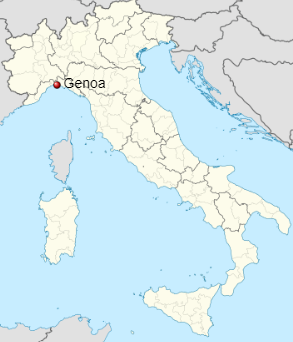
Preserving Basil for the Freshest Taste
Basil freezes well when made into a pesto, and it doesn’t discolor as much as it would if you just freeze the individual basil leaves.
Most classic pesto recipes include nuts, cheese and garlic. While this classic rendition of pesto can be effectively frozen, you will achieve the freshest flavor in your pesto by freezing the basil and oil alone and adding the other ingredients after thawing.
The texture of garlic mellows and deteriorates a bit when frozen. The flavor of cheese will also mellow and lose some of the flavor upon freezing. Freezing pesto without these two ingredients will also allow you to customize after thawing by changing up the nuts or opting for a lighter pesto without cheese.
So, if you want the very freshest pesto in Winter, make a batch that is nothing but basil and olive oil. Seal it and freeze it with thick layer of olive oil on top. When ready to use it, thaw it and add the garlic, nuts and cheese while the pasta water is boiling.
Tip: For preserving the bright green color of pesto, you can “set” its color by first blanching it in boiling water for 30 seconds then plunging leaves into an ice bath.
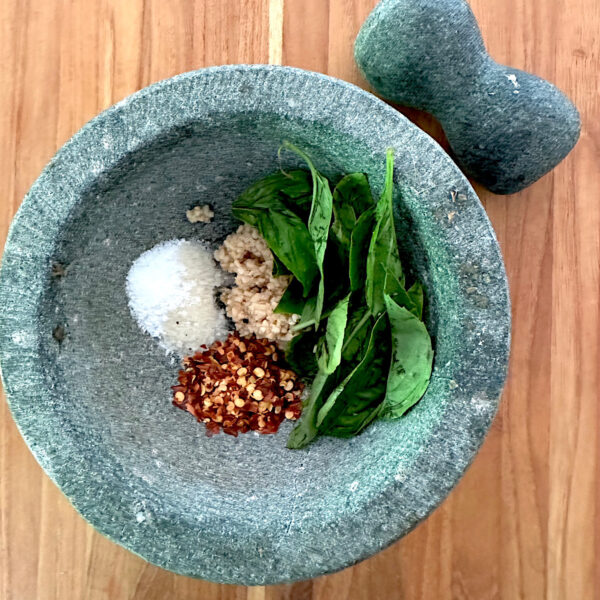
Easiest Way to Freeze Pesto
The ingredients of a classic pesto can be frozen together as a pre-made pesto if you want to save some time when you get ready to use it. If you have all the ingredients on hand and you only want to chop and process once, then by all means make your pesto with the garlic, nuts and cheese and freeze pre-made.
This all-in-one method will save you a little time when you’re thawing it out and want dinner on the table in a hurry.
My favorite recipe is Marcella Hazan’s recipe in the card below. She does not add the cheese before freezing, but she does add the garlic and nuts.
Tip: To thaw frozen pesto, either place in the refrigerator ahead of time or microwave on the defrost setting, stopping and stirring intermittently.
Freeze pesto in large batches if you like to make large pots of pasta family style. Freeze some in small batches when you just want to add flavor to a particular dish. Here are some tips for both methods:
Large Batch
If you enjoy family pasta dinners with pesto, it would be good to freeze it in larger amounts (1/2 to 1 cup), that can be thawed and used right away.
To freeze, transfer the pesto to a sealable container, cover the surface of the pesto with a thin layer of olive oil, tightly seal the container, and place in the freezer. The layer of olive oil will minimize browning on the surface of the pesto as it freezes.
Small Batch
Freezing pesto in ice cube trays (1-2 tablespoons) is great for when you just want a burst of fresh flavor on grilled vegetables or on pizza. Small portions also work well to swirl into soups or salad dressings, or perhaps to top off a bowl of rice.
Tip: frozen pesto should be used within 6 months
How to Use Pesto
Traditional Italian cooks use pesto primarily for seasoning or saucing pasta, and sometimes a dollop in minestrone soup or on focaccia bread. Italian Americans and home cooks around the world also use pesto on pizza or to flavor meats or fish.
Some great ideas for using pesto include:
- A dollop on scrambled eggs or any egg dish.
- A flavorful and colorful accompaniment with salmon, chicken, beef main courses.
- Various “pastas” such as linguine, fetuccine, ravioli, gnocchi.
- Mixed in with pasta salads.
- Swirled into Middle Eastern hummus.
- Added to olive oil and balsamic salad dressing.
- A sauce for any number of sandwiches and wraps.
- With any number of soups.
- A delicious addition to “mac and cheese”.
- Pesto street corn.
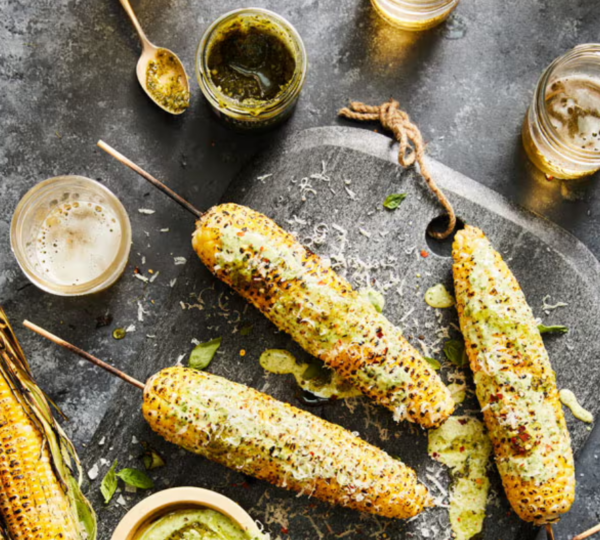
Other Methods for Preserving Summer’s Produce:
- Easy Green Tomato Pickles
- Low Carb Freezer Tomato Sauce with Sumac
- Preserving Fresh Herbs as Herbal Infused Salts
- Freezing Compound Butters made with Fresh Herbs
- Red Pepper & Eggplant Spread for Cheese Trays & Sandwiches
- Homemade Dandelion Jelly
- Salt & Vinegar Cucumber Chips
- Quick & Easy Pickled Onions
- How to Make Shrub Syrups (cold process vs. hot)
- Sun dried tomato butter
Like this recipe? It helps me out greatly if you leave a 5-star 🌟🌟🌟🌟🌟rating in the recipe card below and maybe even leave me a quick comment too!
Basil Pesto for Freezing
Equipment
- medium size bowl
Ingredients
- 2 cups tightly packed basil leaves
- ½ cup olive oil
- 3 tablespoons pine nuts
- 2 garlic cloves
- salt to taste
- ½ cup freshly grated Parmesan Aged Parmiggiano Regianno
- 2 tablespoons freshly grated Pecorino Romano added before serving.
- 3 tablespoons butter room temperature
Instructions
- Briefly soak and wash the basil in cold water, and gently pat it thoroughly DRY with paper towels.If you want to preserve the green color as much as possible, blanch the basil leaves by dunking them quickly in boiling water for 30 seconds, then plunging in ice water before drying.2 cups tightly packed basil leaves
- Put the basil, olive oil, pine nuts, chopped garlic, and an ample pinch of salt in the processor bowl, and process to a uniform, creamy consistency.½ cup olive oil, 3 tablespoons pine nuts, 2 garlic cloves, salt to taste
- If you are making the pesto for the freezer cover it at this point with a layer of olive oil and do not add the cheese and butter.The cheese and butter will be added when it is thawed and before serving.
- When ready to use pesto in your meal, first thaw it out. Transfer to a bowl, and mix in the two grated cheeses by hand. When the cheese has been thoroughly mixed in with the other ingredients, mix in the softened butter, distributing it uniformly into the sauce.½ cup freshly grated Parmesan, 3 tablespoons butter, 2 tablespoons freshly grated Pecorino Romano added before serving.

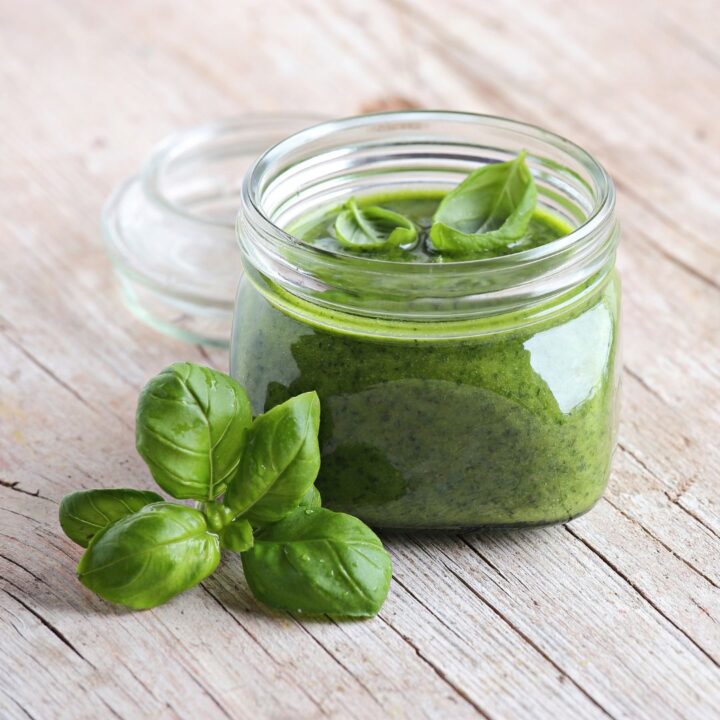
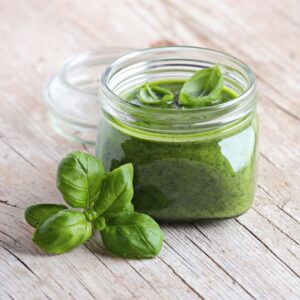
Can I use plastic containers?
Sure Lesley. Just leave some headspace in whatever container you use as the contents will expand in the freezer.